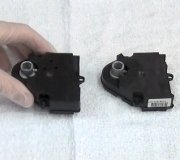This comes right from Honda to the dealers. Try it!
BEFORE REPLACING ELECTRONIC COMPONENTS, TRY THESE TIPS TECHNICAL SERVICE BULLETIN Reference Number(s): HSN 0102-12, � Date of Issue: � January 2002 Related Ref Number(s): HSN 0102-12 ARTICLE BEGINNING SERVICE INFORMATION Many of the electronic components in automobiles have computer chips. Besides ECMs/PCMs, you'll find them stashed in audio units; speedometers; odometers; clocks; climate control systems; control units for ABS, TCS, ATTS, and SRS; security systems; keyless remote transmitters; and multiplex control units. The downsides of all this high-tech stuff are software glitches or bugs, and vulnerability to voltage spikes. And if that isn't enough, static electricity, lightning, ultraviolet light, strong magnetic fields, radio waves, and radar can make a software bug even worse. Before you replace a suspected electronic component, try these tips first. They could spare you unnecessary replacement. � � � Disconnect the positive and negative battery cables, and touch them together for a few minutes. This forces all capacitors in the component to drain, which clears and resets the computer chip. If a software glitch is the cause, resetting the chip this way is usually as effective as installing a new component. � � � Unplug the connectors from the component, wait a few minutes, then reconnect them. If a poor connection is the villain, disengaging and engaging the terminals in the connector cleans contact surfaces and usually fixes the problem. While you have the connector unplugged, look at the pins and terminals for signs of contact. If you have any doubt that things are connecting properly, remove the female pin and use it like you would a feeler gauge to check the contact. If terminals are damaged and need to be replaced, see the article HSN 0800-04 - NEW TERMINAL INSPECTION FEELER TOOL SET, in the August '00 issue of ServiceNews. HONDA: All CATEGORY: Honda Service News APPLIES TO: All Page 1 of 1 BEFORE REPLACING ELECTRONIC COMPONENTS, TRY THESE TIPS -1997 Hon. 7/12/2009
SPEEDOMETER & ODOMETER/TRIP METER 1. If speedometer and odometer/trip meter do not work, check for blown fuse No. 1 (10-amp) in underdash fuse/relay box. Perform VEHICLE SPEED SENSOR (VSS) INPUT TEST under SYSTEM TESTS. Perform VEHICLE SPEED SENSOR (VSS) TEST under COMPONENT TESTS. Repair as necessary. 2. If speedometer works, but odometer/trip meter does not work, check odometer/trip meter. Check printed circuit board. Check odometer connection at printed circuit board. Repair as necessary. 3. If odometer/trip meter works, but speedometer does not work, check speedometer. Check printed circuit board. Repair as necessary.
Tuesday, July 14th, 2020 AT 12:51 PM
(Merged)


